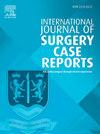Limited hiatal dissection versus Dor-fundoplication in laparoscopic Heller myotomy for achalasia: First experience in Morocco - A case control comparison study
IF 0.6
Q4 SURGERY
引用次数: 0
Abstract
Introduction and importance
Laparoscopic Heller myotomy is a primary treatment for achalasia, addressing impaired esophageal motility. Fundoplication is typically added to prevent postoperative reflux. This study compares outcomes of limited hiatal dissection without antireflux system in laparoscopic Heller myotomy to Dor fundoplication.
Case presentation
A retrospective analysis was conducted on 45 patients treated at visceral surgery department (2008–2022). Of these, 29 patients underwent limited hiatal dissection, and 16 underwent Dor fundoplication. A liquid diet was followed on day one, with discharge on day two, and a semi-liquid diet for three weeks. Outcomes included dysphagia resolution, postoperative Eckardt scores <3, and postoperative reflux incidence. The study compared operative and postoperative data between the two groups.
Clinical discussion
The limited hiatal dissection group had a slightly younger mean age (46.97 years) compared to the Dor fundoplication group (51.75 years). The limited hiatal dissection group had a higher proportion of men (58.6 %) while the Dor group had more women (56.3 %). Dysphagia (100 %) and weight loss (68.9 %) were prevalent symptoms. Perioperative complications and hospital stay duration were similar. Operative time was significantly shorter in the limited hiatal dissection group (96.7 vs. 118.3 min, p = 0.004). Both groups showed similar (OR = 0.519, CI = 0.066–4.083) and significant improvement in dysphagia (91.3 % vs. 87.5 %, p < 0.001) with comparable postoperative gastroesophageal disease (20.7 % vs. 25 %, p = 0.726 OR = 1.278, 95 % CI: 0.301–5.420).
Conclusion
Limited hiatal dissection provides comparable symptom relief and reflux prevention, offering a viable alternative to routine antireflux in achalasia treatment.
简介和重要性:腹腔镜海勒肌切开术是治疗贲门失弛缓症的主要方法,可解决食道运动障碍问题。通常会加上胃底折叠术以防止术后反流。本研究比较了腹腔镜海勒肌切开术和多尔胃底折叠术中不使用抗反流系统的局限性食管裂孔切除术的疗效:本研究对内脏外科治疗的 45 名患者(2008-2022 年)进行了回顾性分析。其中,29 名患者接受了局限性食管裂孔切除术,16 名患者接受了多氏胃底折叠术。患者在术后第一天进食流质饮食,第二天出院,并在三周内进食半流质饮食。结果包括吞咽困难缓解情况、术后 Eckardt 评分和临床讨论:与 Dor 胃底折叠术组(51.75 岁)相比,局限性食道裂孔切除术组的平均年龄(46.97 岁)略小。局限性食道裂孔折叠术组的男性比例较高(58.6%),而 Dor 胃底折叠术组的女性比例较高(56.3%)。吞咽困难(100%)和体重减轻(68.9%)是常见症状。围手术期并发症和住院时间相似。局限性食管裂孔解剖组的手术时间明显更短(96.7 分钟对 118.3 分钟,P = 0.004)。两组患者的吞咽困难情况相似(OR = 0.519,CI = 0.066-4.083),但都有明显改善(91.3% vs. 87.5%,P 结论:有限食道裂孔分离术可缓解症状并预防反流,是贲门失弛缓症治疗中常规抗反流的可行替代方案。
本文章由计算机程序翻译,如有差异,请以英文原文为准。
求助全文
约1分钟内获得全文
求助全文
来源期刊
CiteScore
1.10
自引率
0.00%
发文量
1116
审稿时长
46 days

 求助内容:
求助内容: 应助结果提醒方式:
应助结果提醒方式:


